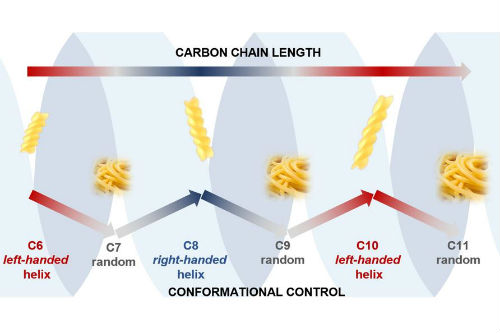Mar 3 2020
In the natural realm, helical shapes are very common. At the molecular level of DNA, the very blueprint of life is itself helical in shape.
Now, researchers from the University of Bristol have discovered that carbon chains also have the ability to take helical shapes. However, in contrast to DNA, their shape relies on the number of atoms in the chain, where chains with even numbers of carbon atoms take helical, fusilli-like shapes, and those with odd numbers of carbon atoms take floppy, spaghetti-like shapes.
 The image shows how the conformation (shape) of our carbon chains alternate between ordered and chaotic structures as the carbon chain alternates between having even and odd numbers of atoms. Image Credit: University of Bristol.
The image shows how the conformation (shape) of our carbon chains alternate between ordered and chaotic structures as the carbon chain alternates between having even and odd numbers of atoms. Image Credit: University of Bristol.
According to the researchers, the difference between chaos and order is a single carbon atom. The study was recently reported in the Nature Chemistry journal. Carbon chains are similar to spaghetti—they are quite floppy and take a set of constantly changing and random shapes.
The Bristol researchers, from the University’s School of Chemistry, demonstrated that when methyl substituents are carefully inserted along carbon chains, their shape could be controlled such that they take well-defined helical (fusilli) or linear (penne) conformations.
The helical conformations have the ability to adopt either right or left-handed helices, and the researchers intended to know the controlling factor behind the type of helix that was formed.
We were astonished to find that the length of the carbon chain (number of carbon atoms) controlled whether the right or left-handed helix formed. Even more surprising was that carbon chains with even numbers of atoms formed well-defined helical structures (fusilli) but odd numbered carbon chains were much floppier and more random in shape (spaghetti).
Varinder Aggarwal, Study Lead Author and Professor, University of Bristol
Aggarwal added, “The change in properties of a homologous series of molecules caused by the single addition of an extra carbon atom is extremely rare—here it results in the difference between order and chaos.”
The odd-even effect of this form has been detected in certain bulk properties, for example, in layers of alkanethiols on a gold surface. However, such properties in solution are not well perceived or recognized.
Professor Aggarwal and his colleagues performed computation and quantification of molecular properties and were able to gain complete insights into the origin of this odd-even effect, which is governed by the end groups. An ordered structure is the result when both the end groups promote the same sense of helicity. By contrast, chaotic structures are obtained when an opposite helix is promoted by each end.
These basic outcomes will govern the design of molecules with preferrable conformational and physical properties for next-generation technological applications.
Carbon chains that have an even number of atoms will form molecules with explicit helical shapes for use as non-switchable rigid materials or as scaffolds to present molecular recognition elements.
In biological molecules such as proteins and DNA, helices are a fundamental structure. Moreover, it is interesting to visualize the analogies to molecules of the type discussed in this study.
Carbon chains with an odd number of atoms were found to adopt floppier and more random shape. We are now studying whether the shape of these chains can in fact be controlled by manipulating the groups at the ends of the chain. This may enable us to switch from one screw-sense to another for applications in responsive materials.
Varinder Aggarwal, Study Lead Author and Professor, University of Bristol